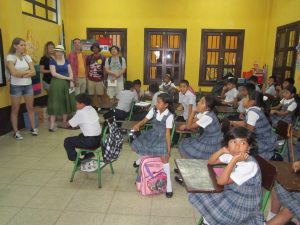
Foreign involvement in Guatemala
This week has been quite a roller coaster, from exploring gorgeous Catholic cathedrals to nearly getting run over by cars on the narrow streets of Antigua. I’m happy I’ve been able to practice my Spanish and grateful that a few of my peers are excellent speakers. It’s been so fun getting to know everyone and have thoughtful discussions about sustainability in developing countries. We’re a very cohesive and funny group! What I thought was especially interesting this week was the ways different parts of the community worked to address social issues.
Tuesday, our first official day in Antigua, was a very busy one. We visited different sites for Common Hope, a non-profit that assists schools and students to increase the national high school graduate rate. They provide social workers, housing, food and scholarships to struggling students and their families. Erin Treinen, our tour guide and development/hospitality manager of Common Hope, introduced us to several students and took us to a home visit. It was very disheartening to see the struggles of these students firsthand, but I’m glad Common Hope is working hard to overcome these obstacles by providing things like primary healthcare, libraries, and many other family resources. Erin gave us the link to sponsor one of these Guatemalan students, so I thought I would share it with anyone who might be interested. (http://www.commonhope.org/get-involved/sponsor/)
 I was reminded of that visit on Thursday, when a small group of us woke up early and walked around Antigua. We briefly attended a mass at a nearby cathedral, with bright streamers hung on the ceiling. That particular mass was targeted at people who were differently-abled and on the wall there was a large bulletin board full of resources for struggling families. It made me consider the relative effectiveness of Common Hope, an organization started by an American couple, versus a more traditional community church group. They both appeared to be reaching lots of people, and I wondered about the strengths and weaknesses of each approach. A church has established a high level of trust in a community but fewer financial resources whereas a foreign organization must work must harder to earn a community’s trust but finds resources more easily. This also made me wonder if they were working towards the same goal. The ultimate goal of Common Hope was to get students an education in order to find a job (perhaps elsewhere in the country or even the world), while a church might be more interested in strengthening community bonds. This is something we should always keep in mind when giving foreign aid. Are we supporting the values and relationships within a community, or are we pushing our own ideals onto people because we assume everyone shares them? I don’t want to make it sound like I’m criticizing Common Hope (they have done some amazing work that I was able to witness firsthand), but it’s a questionable gray area that all non-local organizations have to address carefully.
I was reminded of that visit on Thursday, when a small group of us woke up early and walked around Antigua. We briefly attended a mass at a nearby cathedral, with bright streamers hung on the ceiling. That particular mass was targeted at people who were differently-abled and on the wall there was a large bulletin board full of resources for struggling families. It made me consider the relative effectiveness of Common Hope, an organization started by an American couple, versus a more traditional community church group. They both appeared to be reaching lots of people, and I wondered about the strengths and weaknesses of each approach. A church has established a high level of trust in a community but fewer financial resources whereas a foreign organization must work must harder to earn a community’s trust but finds resources more easily. This also made me wonder if they were working towards the same goal. The ultimate goal of Common Hope was to get students an education in order to find a job (perhaps elsewhere in the country or even the world), while a church might be more interested in strengthening community bonds. This is something we should always keep in mind when giving foreign aid. Are we supporting the values and relationships within a community, or are we pushing our own ideals onto people because we assume everyone shares them? I don’t want to make it sound like I’m criticizing Common Hope (they have done some amazing work that I was able to witness firsthand), but it’s a questionable gray area that all non-local organizations have to address carefully.

